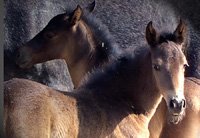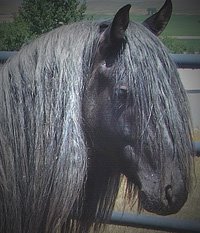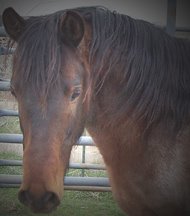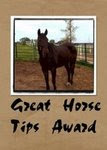 Any person who has tried to trace the history of a breed, equine or otherwise, knows that much is lost to the mists of time. Even among the relatively small number of Barb devotees in North America today, disagreement abounds about the exact history of the breed. Much of what I have written here is extrapolated from the work of Dr. Deb Bennett, one of the world's foremost equine experts and a respected researcher and paleontologist. For further detail, see Dr. Bennett's article on The Origins and Relationships of the Mustang, Barb, and Arabian Horse, available on the Equine Studies Institute website.
Any person who has tried to trace the history of a breed, equine or otherwise, knows that much is lost to the mists of time. Even among the relatively small number of Barb devotees in North America today, disagreement abounds about the exact history of the breed. Much of what I have written here is extrapolated from the work of Dr. Deb Bennett, one of the world's foremost equine experts and a respected researcher and paleontologist. For further detail, see Dr. Bennett's article on The Origins and Relationships of the Mustang, Barb, and Arabian Horse, available on the Equine Studies Institute website.More than 3,000 years ago, horses of Afro-Turkic extraction were brought by sailing vessel from the Mediterranean to France and the British aisles. These horses, when bred with the native, draft-type, Iberian horses, produced unusually hardy foals capable of greater endurance than either their sires or their dams.
The Iberian crossbreds traveled, in the hands of traders, to what would one day become Spain. King Solomon possessed them, then Hannibal, then the Romans and the Numidian cavalry from North Africa. In the fifth century A.D., northern invaders stole herds of Iberian horses from Gibralter and shipped them to North Africa, where they were backcrossed on the blood of their ancestors.
The resulting Barbary Horses, or Barbs, retained some characteristics of their Iberian influence. However, the infusion of Afro-Turkic bloodlines resulted in a lighter body type. Less refined for beauty than the Arabian, another ancient breed heavily influenced by the Afro-Turkic stock, Barbs were characterized by exceptional endurance and soundness of the legs and hooves. Their profiles were straight or sub-convex, their cannon bones round rather than oblong, their backs short and strong, their croups sloped to low-set tails, ideal for the crouching and spinning maneuvers required by North African warriors.
Here, the history grows murkier. Dr. Bennett’s article continues to explain the influence of the Barb on the Jennet, which experienced renewed draft influence in Spain and came to the New World in Columbus’ time, ultimately resulting in the so-called American “mustang.”
However, Robert Painter of Quien Sabe Ranch notes that his horses are not products of the hodgepodge of draft, thoroughbred, and other miscellaneous bloodlines so common among modern “mustangs,” that is, feral horses of non-specific type. Additionally, he believes his horses represent the original Barb that moved from North Africa to Spain, and from there to the New World with the Conquistadors. While most of the pure Barbs in Africa and Spain have been crossbred into oblivion, Painter has spent more than half a century gathering horses he believes to be of the original type, preserving their purity on his ranch near Midvale, Idaho. It is from this herd that In the Night Farm’s stock comes.
Painter’s understanding of Barb history is briefly presented in the Breed Profile Section of the March 2008 issue of The Northwest Horse Source, together with a photo of In the Night Farm’s 2000 stallion, Insider (Idaho Night Hawk x Chispa, IBHR 191). The same photo accompanies this post.
So, what do I believe about our horses? I believe they are representatives of ancient bloodlines, unusually sound of mind and body, rare, and able to improve nearly any other horse with whom they are crossed. The precise details of their origins remain a fascinating mystery.









2 comments:
This is very interesting! I hope you continue to track the progress of your horses in endurance. I'd love to hear more about how you chose your horses. I remember Quien Sabe's site from long ago (I must have googled "roan horse"! My fave color).
After having briefly lost your info, I found it again. I added you to my Colonial Spanish Horse entry (I know there's probably a lot of nitpicking about exactly what type of horse is what, but it's a start).
Cheers,
girasol, www.globalhorseculture.com
Hi again, and thanks for the link on your blog...which I love, by the way! All the best to you.
Post a Comment